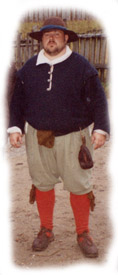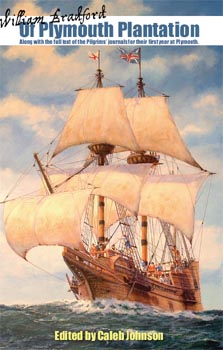Clothing
The Pilgrims are often depicted in popular culture as wearing only black and white clothing, with large golden buckles on their shoes and hats and long white collars. This stereotypical Pilgrim, however, is not historically accurate. The Pilgrims, in fact, wore a wide variety of colors. This is known because when a person died, an inventory was made of their estate for the purpose of probate: and often the color of various clothing items were mentioned. For example, long-time church member, Mary Ring, died in Plymouth in 1633, and her estate included a "mingled-color" waistcoat, two violet waistcoats, three blue aprons, a red petticoat, a violet petticoat, blue stockings, and white stockings. In addition, she owned gray cloth, blue cloth and red cloth, ready to make additional clothing. Plymouth's Church Elder William Brewster, who died in 1644, owned green pants, a red cap, a violet coat, and a blue suit. And Governor William Bradford, when he died in 1657, owned a green gown, violet cloak, and a red waistcoat.
Women's clothing
A woman's undergarment was a
long off-white short-sleeved, linen shirt called a shift, which somewhat
resembled a modern-day woman's nightshirt except that it was ribbon-tied at the
collar and cuffs and fastened in the front. One or more ankle-length,
waist-fastened petticoats were worn. The dress, or gown, consisted of two parts,
a bodice and a skirt. Sometimes the sleeves were a separate part as well, being
tied to the bodice. The bodice or the skirt could be the same or different
colors, and were often made of wool. The bodice buttoned all the way down the front.
The skirt was ankle-length and gathered at the waist. A long-sleeve fitted
waistcoat was often worn over the top, and an apron was worn if the woman was
doing any kind of work. Women occasionally wore lace collar and cuffs, and a
cloak. Women's hair was always worn pulled tightly back, and gathered under a
coif or hat.
Men's clothing
For the upper body, men usually wore a long,
short-sleeved, off-white linen shirt, with collar. On top of that he wore a
doublet, which was relatively close-fitting, with long sleeves, broad padded
shoulders, and buttoned down the front with tabs at waist. A cloak was sometimes draped over the shoulders. A lace collar and cuffs were worn, as was a felt or
knit cap. Older or more revered men often wore over the top of everything a
full-length wool gown. For the lower body, breeches or drawers were usually
worn. These were front-buttoning, rather baggy pants which extended to the knee
level. Stockings were knee-length, often made of wool; they were held up with
tied ribbons referred to as garters. Shoes were either low cut leather shoes,
or higher-cut leather boots.
Children's clothing
Until about the age of eight, children--both
boys and girls--wore gowns. These gowns were similar to a woman's dress, with a
full-length skirt, high neckline, and long sleeves, but were laced up and
fastened in the back. Older boys simply wore smaller versions of men's
clothing, and older girls wore smaller versions of women's clothing.





